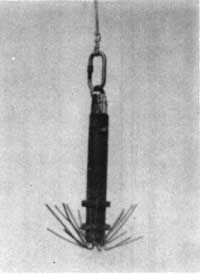Tribute to the Clarity of Crater Lake
The depth below the surface to which green plants are able to penetrate depends primarily on the availability of light, which is essential for photosynthesis. Turbidity, color, and amount of surface disturbance are the prime factors in determining the depth to which sufficient light for photosynthesis will penetrate. Based in large part upon these conditions, green plants occupy what is termed the photosynthetic zone, the upper six to seventeen feet (two to five meters) of water in most lakes. The growth of mosses at a depth greater than 400 feet (122 meters) in Crater Lake is therefore a tribute to the clarity of its water.
 Peters grapple used by the authors |
Hasler (1938), a member of the naturalist staff at Crater Lake National Park during the summers of 1937 and 1938, states that, “The most startling biological finding at Crater Lake was the collection, by dredge, of green mosses…at the astonishing depth of 394 feet (120 meters). This is the greatest depth that growing green plants have been known to live in any fresh water body.” (Hasler, 1937).
Collections made this past summer, using the grapple pictured, confirm and extend Hasler’s findings, which indicated that green plants cover a large part of the bottom of Crater Lake down to a remarkable depth. Mosses were collected by the authors from maximum depths of 384 feet (117 meters) in Cleetwood Cove, 410 feet (125 meters) at a point south of Wizard Island, and 425 feet (129 meters) at a place south of the Wineglass. In fact, very few attempts below 110 feet failed to be rewarding in this respect. Material from this 425 foot collection has been identified asDrepanocladus fluitans (Hedw.) Warnst. by Dr. Francis Drouet, Curator of Cryptogamic Botany, Chicago Natural History Museum, to whom appreciation is expressed for making this determination.
These figures do not necessarily represent maximum depths at which mosses occur in Crater Lake. They represent, rather, near-maximum working depths attainable with the 450 feet of cable available for the operations. Two other factors need to be considered in interpreting these figures: (1) the difficulty in locating a portion of the generally steep-sloping lake bottom that allows full use of the equipment, and (2) the difficulty in then maneuvering a small boat so as to remain over such a spot.
The minimum depth at which mosses occur in Crater Lake appears to be more definable. Hasler (1938) found no moss above a depth of sixty feet, and the least depth at which we recovered mosses was eighty-five feet. In some areas, such as at Cleetwood Cove and Eagle Cove, no mosses were obtained at depths less than 110 feet.
It is difficult to suggest valid reasons for such findings. Wave action could be a factor, although the situation at Fumarole Bay, which is quite protected and in which mosses are not found at lesser depths than elsewhere in the lake, would seem to preclude this explanation. Another possibility is that the species may be light intolerant. Collections of mosses made from a log (Brode, 1938; Fairbanks, 1953), called the “Old Man of the Lake,” that has been floating about the lake for many years in a vertical, “dead-head” position, would seem to lend doubt to such a conclusion. It appears that this problem will not yield to simple explanation and will have to await further investigation.
References
Brode, J. Stanley. 1938. The denizens of Crater Lake. Northwest Sci. 12(3):50-57.
Fairbanks, C. Warren. 1953. The Crater Lake community. Nature Notes from Crater Lake 19:21-25.
Hasler, Arthur D. 1937. Preliminary report on bottom flora and fauna of Crater Lake. (MS. in Crater Lake National Park Library).
—–. 1938. Fish biology and limnology of Crater Lake, Oregon. Journ. Wildlife Management 2(3):94-103.

